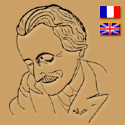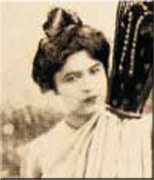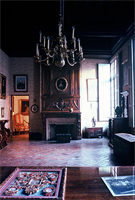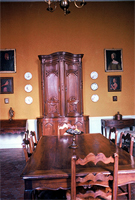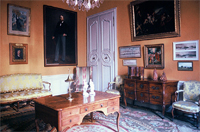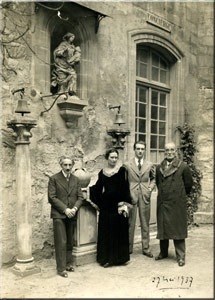| Jeanne de Flandreysy |  |
| excerpts from “the poets I have known”: To keep these image archives a frame worthy of them, which kept them in order, but also in fervor and beauty, Jeanne de Flandreysy after having bought the Palais du Roure, in the heart of Avignon, where the popes have seventy years reigned by the Spirit, restored the hotel, which threatened to ruin, of the noble family of Baroncelli. It has purified its ancestors, removed the disparate additions, restored everything to its original balance. In this framework thus restored in beauty, she knew how to bring together books, paintings, etchings, charcoals, souvenirs, engravings, autograph letters of great poets and in particular of Mistral who, thanks to her, will one day add to all her glories that of great letter-writer. Of this immense work, only Posterity will be able to give Praise to this Our Lady of the Latin archives. Dear Roure, whose real face I have seen, year after year! I hear the saws cutting stones or wood, hammers driving nails and dowels, I see the walls adorned with prestigious drawings, moving memories, shadows pass through the rooms, enveloped in their meditations, Henri de Groux, Louis le Cardonnel, Emile Espérandieu and so many others, poets, scholars, artists, all bringing something of themselves, but also carrying something, advice, comfort, a talisman, the spiritual benefit of this rigor, of this demanding discipline and of this enthusiasm too, “flame in crystal”, in the words of Louis le Cardonnel, ordered fire which illuminates without burning, when so many others burn without illuminating. It was in Roure that Jeanne de Flandreysy extracted gravel and mud from history, carried along by the great Gallo-Roman river, the gold flakes that it shines in our eyes.
She invited me to come and see her in her apartment in rue de Chaillot, very nicely decorated with Provencal souvenirs. She then had very fine literary connections, wrote to Le Figaro, and through her Provençal works ensured the literary secretariat of Jules Charles-Roux, deputy of Marseille and president of the Transatlantic Company, who, very attached to his native country, devoted a series to her. sumptuous works, illustrated by photography, drawing and watercolor and for which Madame de Flandreysy gathered documents through museums in Provence, France and even abroad. From my rather melancholy Normal School, I therefore found myself in the midst of the effervescence of Provence, entering this environment, where I had a lot to learn. Mme de Flandreysy, in fact, daughter of M. Etienne Mellier, archivist-librarian of the Archaeological Society of Drôme, had a real heritage of intellectual research, a very lively intelligence, an exquisite taste and an obstinate courage in the task. A poet herself, she wrote very pretty verses which she gathered too late at the whim of her friends, of whom she always thought more than herself. It was only after the war of 1914-1918 that I renewed this friendship, which was never to be eclipsed. Madame de Flandreysy had acquired there in 1917 the hotel of Baroncelli in Avignon, she had undertaken to restore this admirable house, to house the iconographic collections and the archives there only after 15 years of collaboration with Jules Charles-Roux, who came to die in 1917, remained his property, to give them a framework worthy of them and to receive there all the intellectual elite, which was interested in Provence, Felibrige, Dante, Petrarch, the Popes of Avignon, to Roman Gaul, to everything that was to make the Palais du Roure (as the Hotel des Baroncelli was commonly called), in 25 years of work a luminous center of mistralism and Latinity.
In truth Jeanne de Flandreysy entered Roure, as one enters into religion and when one thinks of her one repeats these beautiful verses that Le Cardonnel applied to another great literate lady: “You evoke the days of ancient Italy, Now, coming almost to the end of her task, she offered her work to the city of Avignon. Poet for having written some elegant and noble verses, Mme de Flandreysy was even more so and above all for having erected before us this stone poem, full of noble and charming evocations, all rustling with the bells she loved so much and so piously assembled, all illuminated with Provençal memories. Louis Le Cardonnel said to him jokingly “You are the archivist of Eternity“. In his youth, Mistral had sung it in this truly flattering quatrain:
Finally, beyond all the friendly tributes, Folco de Baroncelli had dedicated to him from his first steps in the Camargue a fiery poem, in which the violence and ardor of his feelings were clearly marked, which were not to be denied for 40 years.
|
Jeanne de Flandreysy: Woman of letters, is passionate with her father, Étienne Mellier, for History and the Arts. In 1918, it bought the Palais du Roure (Avignon) from the Baroncelli family to establish a center of Mediterranean culture.
